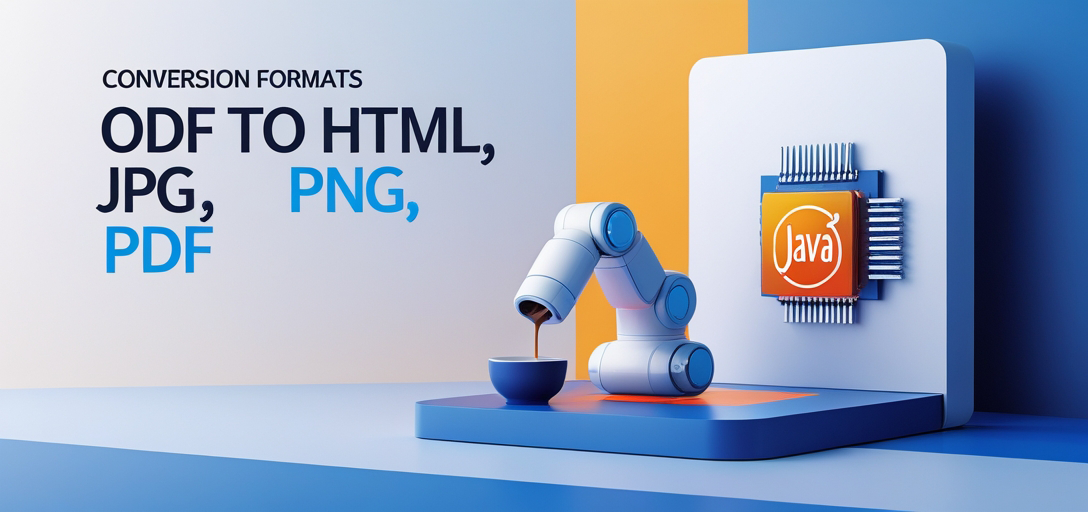Convert ODF Documents to Various Formats Using GroupDocs.Viewer for Java
Introduction
Struggling with converting OpenDocument Format (ODF) files into versatile formats like HTML, JPG, PNG, or PDF? This tutorial guides you through rendering FODG/ODG documents using GroupDocs.Viewer for Java. By the end, you’ll know how to convert ODF documents into multiple formats using Java.

Prerequisites
Before starting, ensure you have:
Required Libraries and Dependencies
- GroupDocs.Viewer for Java (integratable via Maven)
Environment Setup Requirements
- JDK installed (Java 8 or higher recommended)
- Compatible IDE like IntelliJ IDEA or Eclipse
Knowledge Prerequisites
- Basic understanding of Java programming
- Familiarity with Maven for dependency management
Setting Up GroupDocs.Viewer for Java
Add the following to your pom.xml:
<repositories>
<repository>
<id>repository.groupdocs.com</id>
<name>GroupDocs Repository</name>
<url>https://releases.groupdocs.com/viewer/java/</url>
</repository>
</repositories>
<dependencies>
<dependency>
<groupId>com.groupdocs</groupId>
<artifactId>groupdocs-viewer</artifactId>
<version>25.2</version>
</dependency>
</dependencies>
License Acquisition
GroupDocs offers a free trial or purchase options. Acquire a temporary license here to explore full capabilities without limitations.
Implementation Guide
We’ll break down each feature into logical steps:
Feature 1: Render FODG/ODG Document to HTML
Overview
Converting ODF documents to HTML allows them to be displayed in web browsers, ideal for sharing online or integrating into web applications.
Implementation Steps
Step 1: Set Up the Output Directory Define where converted files will be stored:
Path outputDirectory = Path.of("YOUR_OUTPUT_DIRECTORY");
Path pageFilePathFormat = outputDirectory.resolve("fodg_result.html");
Step 2: Initialize Viewer and Render to HTML
Use HtmlViewOptions for rendering with embedded resources:
try (Viewer viewer = new Viewer("YOUR_DOCUMENT_DIRECTORY/SAMPLE_FODG")) {
HtmlViewOptions options = HtmlViewOptions.forEmbeddedResources(pageFilePathFormat);
viewer.view(options);
}
Explanation: HtmlViewOptions.forEmbeddedResources() configures rendering to embed resources directly into the HTML.
Feature 2: Render FODG/ODG Document to JPG
Overview
Rendering documents to JPEG is ideal for previewing content where high-resolution images are unnecessary.
Implementation Steps
Step 1: Set Up the Output Directory Define your output file path:
Path outputDirectory = Path.of("YOUR_OUTPUT_DIRECTORY");
Path pageFilePathFormat = outputDirectory.resolve("fodg_result.jpg");
Step 2: Initialize Viewer and Render to JPG
Set up JpgViewOptions for rendering:
try (Viewer viewer = new Viewer("YOUR_DOCUMENT_DIRECTORY/SAMPLE_FODG")) {
JpgViewOptions options = new JpgViewOptions(pageFilePathFormat);
viewer.view(options);
}
Explanation: JpgViewOptions configures the document to be rendered as a JPEG image.
Feature 3: Render FODG/ODG Document to PNG
Overview
PNG format is suitable for high-quality, lossless images, ideal when clarity and detail are important.
Implementation Steps
Step 1: Set Up the Output Directory Define your output file path:
Path outputDirectory = Path.of("YOUR_OUTPUT_DIRECTORY");
Path pageFilePathFormat = outputDirectory.resolve("fodg_result.png");
Step 2: Initialize Viewer and Render to PNG
Set up PngViewOptions for rendering:
try (Viewer viewer = new Viewer("YOUR_DOCUMENT_DIRECTORY/SAMPLE_FODG")) {
PngViewOptions options = new PngViewOptions(pageFilePathFormat);
viewer.view(options);
}
Explanation: PngViewOptions configures the document to be rendered as a PNG image.
Feature 4: Render FODG/ODG Document to PDF
Overview
Converting documents to PDF preserves formatting across platforms, making it popular for creating shareable and printable files.
Implementation Steps
Step 1: Set Up the Output Directory Define your output file path:
Path outputDirectory = Path.of("YOUR_OUTPUT_DIRECTORY");
Path pageFilePathFormat = outputDirectory.resolve("fodg_result.pdf");
Step 2: Initialize Viewer and Render to PDF
Set up PdfViewOptions for rendering:
try (Viewer viewer = new Viewer("YOUR_DOCUMENT_DIRECTORY/SAMPLE_FODG")) {
PdfViewOptions options = new PdfViewOptions(pageFilePathFormat);
viewer.view(options);
}
Explanation: PdfViewOptions configures the document to be rendered as a PDF file.
Practical Applications
- Web Integration: Embed HTML-rendered documents in web applications for easy access.
- Document Previewing: Use JPG or PNG formats for quick previews in content management systems.
- Report Generation: Create printable reports from ODF files in PDF format.
- Offline Viewing: Save documents as images (JPG/PNG) for offline viewing on devices without internet access.
Performance Considerations
- Optimize Resource Usage: Ensure sufficient storage and handle large file sizes efficiently.
- Memory Management: Use efficient Java coding practices to manage memory, especially with large documents.
- Best Practices: Regularly update GroupDocs.Viewer for performance improvements and bug fixes.
Conclusion
This tutorial explored converting ODF documents into various formats using GroupDocs.Viewer for Java. Integrate these features into web applications or create printable reports efficiently. Explore advanced features of GroupDocs.Viewer to enhance your projects.
FAQ Section
- Can I convert large ODF files?
- Yes, but ensure adequate system resources are available.
- How do I handle licensing for production use?
- Purchase a license from the GroupDocs website.
- Is it possible to convert ODF documents in bulk?
- Yes, automate and batch process multiple files using Java’s file handling capabilities.
- What if I encounter rendering errors?
- Check document format compatibility and ensure GroupDocs.Viewer is up-to-date.
- Can these features be integrated into existing systems?
- Absolutely! GroupDocs.Viewer for Java integrates easily with various systems.